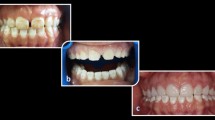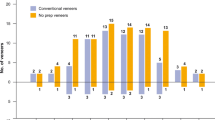Abstract
The purpose of this study was to evaluate the clinical performance of laminate porcelain veneers bonded with a light-cured composite. Thirty patients were restored with 119 porcelain laminate veneers. The veneers were studied for an observation time of 7 years. Marginal adaptation, marginal discoloration, secondary caries, color match, and anatomic form were clinically examined following modified United States Public Health Service (USPHS) criteria. Each restoration was also examined for cracks, fractures, and debonding. Pulp vitality was verified. In addition, plaque and gingival indexes and increase in gingival recession were recorded. Survival rate evaluating absolute failures and success rate describing relative failures were statistically determined, using both restoration and patient-related analyses. On the basis of the criteria used, most of the veneers rated Alfa. After 7 years, the results of the clinical investigation regarding marginal adaptation and marginal discoloration revealed only 2.5% and 4.2% Bravo ratings, respectively, among the 119 initially placed veneers. Using the restoration as the statistical unit, the survival rate was 97.5%, with a high estimated success probability of 0.843 after 7 years. Using the patient as the statistical unit, the survival rate was 90.0% and the estimated success probability after 7 years was 0.824. Gingival response to the veneers was all in the satisfactory range. Porcelain laminate veneers offer a predictable and successful treatment modality giving a maximum preservation of sound tooth. The preparation, cementation, and finishing procedures adopted are considered key factors for the long-term success and aesthetical result of the veneer restorations.




Similar content being viewed by others
References
Dumfahrt H, Schaffer H (2000) Porcelain laminate veneers. A retrospective evaluation after 1 to 10 years of service: part II—clinical results. Int J Prosthodont 13:9–18
Fradeani M (1998) Six-year follow-up with Empress veneers. Int J Periodontics Restorative Dent 18:216–225
Fradeani M, Redemagni M, Corrado M (2005) Porcelain laminate veneers: 6- to 12-year clinical evaluation—a retrospective study. Int J Periodontics Restorative Dent 25:9–17
Peumans M, De Munck J, Fieuws S, Lambrechts P, Vanherle G, Van Meerbeek B (2004) A prospective ten-year clinical trial of porcelain veneers. J Adhes Dent 6:65–76
Smales RJ, Etemadi S (2004) Long-term survival of porcelain laminate veneers using two preparation designs: a retrospective study. Int J Prosthodont 17:323–326
Guess PC, Stappert CF (2008) Midterm results of a 5-year prospective clinical investigation of extended ceramic veneers. Dent Mater 24:804–813
Aykor A, Ozel E (2009) Five-year clinical evaluation of 300 teeth restored with porcelain laminate veneers using total-etch and a modified self-etch adhesive system. Oper Dent 34:516–523
Peumans M, Van Meerbeek B, Lambrechts P, Vanherle G (2000) Porcelain veneers: a review of the literature. J Dent 28:163–177
Cötert HS, Dündar M, Oztürk B (2009) The effect of various preparation designs on the survival of porcelain laminate veneers. J Adhes Dent 11:405–411
D'Arcangelo C, De Angelis F, Vadini M, Zazzeroni S, Ciampoli C, D'Amario M (2008) In vitro fracture resistance and deflection of pulpless teeth restored with fiber posts and prepared for veneers. J Endod 34:838–841
D'Arcangelo C, De Angelis F, Vadini M, D'Amario M, Caputi S (2010) Fracture resistance and deflection of pulpless anterior teeth restored with composite or porcelain veneers. J Endod 36:153–156
Matsumura H, Aida Y, Ishikawa Y, Tanoue N (2006) Porcelain laminate veneer restorations bonded with a three-liquid silane bonding agent and a dual-activated luting composite. J Oral Sci 48:261–266
Celik C, Gemalmaz D (2002) Comparison of marginal integrity of ceramic and composite veneer restorations luted with two different resin agents: an in vitro study. Int J Prosthodont 15:59–64
Acquaviva PA, Cerutti F, Adami G, Gagliani M, Ferrari M, Gherlone E, Cerutti A (2009) Degree of conversion of three composite materials employed in the adhesive cementation of indirect restorations: a micro-Raman analysis. J Dent 37:610–615
Ozyesil AG, Usumez A, Gunduz B (2004) The efficiency of different light sources to polymerize composite beneath a simulated ceramic restoration. J Prosthet Dent 91:151–157
Rasetto FH, Driscoll CF, von Fraunhofer JA (2001) Effect of light source and time on the polymerization of resin cement through ceramic veneers. J Prosthodont 10:133–139
Belser UC, Magne P, Magne M (1997) Ceramic laminate veneers: continuous evolution of indications. J Esthet Dent 9:197–207
Mangani F, Cerutti A, Putignano A, Bollero R, Madini L (2007) Clinical approach to anterior adhesive restorations using resin composite veneers. Eur J Esthet Dent 2:188–209
Magne P, Belser UC (2004) Novel porcelain laminate preparation approach driven by a diagnostic mock-up. J Esthet Restor Dent 16:7–16, discussion 17–18
Stappert CF, Ozden U, Gerds T, Strub JR (2005) Longevity and failure load of ceramic veneers with different preparation designs after exposure to masticatory simulation. J Prosthet Dent 94:132–139
Magne P (2005) Immediate dentin sealing: a fundamental procedure for indirect bonded restorations. J Esthet Restor Dent 17:144–154, discussion 155
Cvar JF, Ryge G (1971) Criteria for the clinical evaluation of dental restoration materials. US Public Health Service Publication No. 790. Government Printing Office, San Francisco
Cvar JF, Ryge G (2005) Reprint of criteria for the clinical evaluation of dental restorative materials, 1971. Clin Oral Investig 9:215–232
Bayne SC, Schmalz G (2005) Reprinting the classic article on USPHS evaluation methods for measuring the clinical research performance of restorative materials. Clin Oral Investig 9:209–214
Silness J, Loe H (1964) Periodontal disease in pregnancy. II. Correlation between oral hygiene and periodontal condition. Acta Odontol Scand 22:121–135
Loe H, Silness J (1963) Periodontal disease in pregnancy. Prevalence and severity. Acta Odontol Scand 21:533–551
Kihn PW, Barnes DM (1998) The clinical longevity of porcelain veneers: a 48-month clinical evaluation. J Am Dent Assoc 129:747–752
Roulet JF (2000) Longevity of glass ceramic inlays and amalgam—results up to 6 years. Clin Oral Investig 1:40–46
Rouse JS (1997) Full veneer versus traditional veneer preparation: a discussion of interproximal extension. J Prosthet Dent 78:545–549
Knoernschild KL, Campbell SD (2000) Periodontal tissue responses after insertion of artificial crowns and fixed partial dentures. J Prosthet Dent 84:492–498
Conflict of interest
The authors declare that they have no conflict of interest.
Author information
Authors and Affiliations
Corresponding author
Rights and permissions
About this article
Cite this article
D’Arcangelo, C., De Angelis, F., Vadini, M. et al. Clinical evaluation on porcelain laminate veneers bonded with light-cured composite: results up to 7 years. Clin Oral Invest 16, 1071–1079 (2012). https://doi.org/10.1007/s00784-011-0593-0
Received:
Accepted:
Published:
Issue Date:
DOI: https://doi.org/10.1007/s00784-011-0593-0




